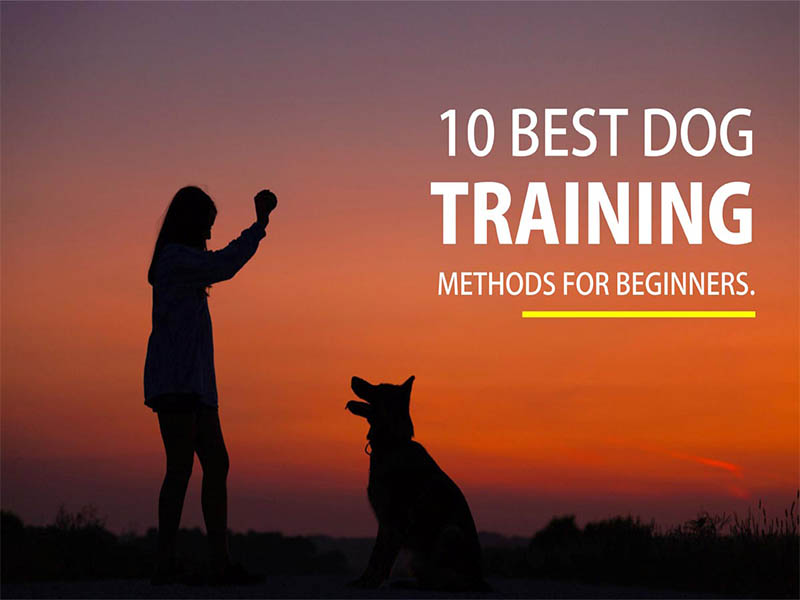10 Best Dog Training Methods For Beginners
Top 10 training tips:
1. Choose your dog`s name wisely and be respectful of it. Of course, you will want to pick a name for your new puppy or dog that you love, but for training, it also helps to consider a short name ending with a strong consonant. This allows you to say his name so that he can always hear it. A strong ending (i.e. Jasper, Jack, Ginger) perks up puppy ears - especially when you place a strong emphasis at the end.
2. Decide on the "house rules." Before he comes home, decide what he can and can`t do. Is he allowed on the bed or the furniture? Are parts of the house off-limits? Will he have his chair at your dining table? If the rules are settled on early, you can avoid confusion for both of you.
3. Set up his private den. He needs "a room of his own." From the earliest possible moment give your pup or dog his own, private sleeping place that is not used by anyone else in the family, or another pet. He will benefit from short periods left alone in the comfort and safety of his den. Reward him if he remains relaxed and quiet. His den, which is often a crate, will also be a valuable tool for housetraining.
4. Help him relax when he comes home. When your puppy gets home, give him a warm hot water bottle and put a ticking clock near his sleeping area. This imitates the heat and heartbeat of his littermates and will soothe him in his new environment. This may be even more important for a new dog from a busy, loud shelter who is had a rough time early on. Whatever you can do to help him get comfortable in his new home will be good for both of you.
5. Teach him to come when called. Come, Jasper! Good boy! Teaching him to come is the command to be mastered first and foremost. And since he will be coming to you, your alpha status will be reinforced. Get on his level and tell him to come using his name. When he does, make a big deal using positive reinforcement. Then try it when he is busy with something interesting. You will see the benefits of perfecting this command early as he gets older.
6. Reward his good behavior. Reward your puppy or dog`s good behavior with positive reinforcement. Use treats, toys, love, or heaps of praise. Let him know when`s he is getting it right. Likewise, never reward bad behavior; it will only confuse him.
7. Take care of the jump up. Puppies love to jump up in greeting. Don`t reprimand him, just ignore his behavior and wait "till he settles down before giving positive reinforcement. Never encourage jumping behavior by patting or praising your dog when he`s in a "jumping up" position. Turn your back on him and pay him no attention.
8. Teach him about "dog time" Puppies and dogs live in the moment. Two minutes after they`ve done something, it`s forgotten about. When he`s doing something bad, try your chosen training technique right away so he has a chance to make the association between the behavior and the correction. Consistent repetition will reinforce what`s he is learned.
9. Discourage him from biting or nipping. Instead of scolding him, a great way to put off your mouthy canine is to pretend that you are in great pain when he is biting or nipping you. He will be so surprised he is likely to stop immediately. If this doesn`t work, try trading a chew toy for your hand or pant leg. The swap trick also works when he`s into your favorite shoes. He will prefer a toy or bone anyway. If all else fails, break up the biting behavior, and then just ignore him.
10. End training sessions on a positive note. Excellent boy! Good job, Jasper! He`s worked hard to please you throughout the training. Leave him with lots of praise, a treat, some petting, or five minutes of play. This guarantees he will show up at his next class with his tail wagging - ready to work!
Basic Tools for Training Your Dog
Clicker- A clicker can be used to mark desired behavior, both in response to a cue and when it occurs naturally. Clickers come in a variety of shapes and styles, including handheld ones and those with wrist straps. Some leashes even come with built-in clickers. There are also clicker apps for your smartphone and clickers designed for training multiple dogs, with different distinct sounds for each pooch.
Target stick- A target stick can help teach basic behaviors like walking nicely on a leash or complex tricks like spin or bow. Targets vary from a simple, fixed-length stick to something fancier, like a stick with a built-in clicker or one that collapses for easy storage. A serving spoon or wooden spoon can also be an easy DIY target — or you can skip the equipment altogether and teach your dog to touch and follow a hand target.
Treats- Rewards keep your dog interested and motivated. Treat preference will vary depending upon the individual canine, but in general, soft, meaty treats are canine favorites. Treats should be small, around the size of a pencil eraser or a blueberry. Some come pre-sized for training while others may be broken apart or cut down to size before training.
Portable Mat- A portable mat or bed provides a safe space for your dog to settle, no matter where he is. A foldable, washable bed, mat, or blanket is easy to transport and ideal for outings. Varieties with a sticky bottom tend to provide greater stability on slick surfaces.
Leashes- Training Leashes vary in length, typically between four and six feet. Ideally, the leash is long enough to allow slight slack when your dog stays close to you during walks (rather than being pulled tight all the time). A waist-clip leash enables you to keep your hands free during training sessions. Store your dog’s leashes in easy access locations, such as on hooks near the door.
Collar and Harness- A flat collar holds your dog’s ID Tag, which is important if he gets out on his own. While you can also clip a leash to a flat collar, a front-clip harness is a better option for most dogs, since it can help deter pulling and make it easier for you to guide your dog’s movement. For difficult-to-control dogs, a head halter can be a useful option. (Note: Corrective collars are not recommended for training.)
Longline- When your dog is ready to practice behaviors like long-distance stays and come when called, a long line is a safe and simple alternative to being off-leash. Long lines also allow for exploration during training breaks and extra room to walk out for activities like scent detection. Standard long lines vary from 15 to 30 feet.
Barriers- Crates, pet gates, pet pens, and playpens can be useful if you need to contain your dog in a certain area for situations like house training or chewing management. A barrier can also help keep your pooch away from problem areas like stairs or the front door.
Published By: Admin
Published On: 27-April-2020

 0
0 








